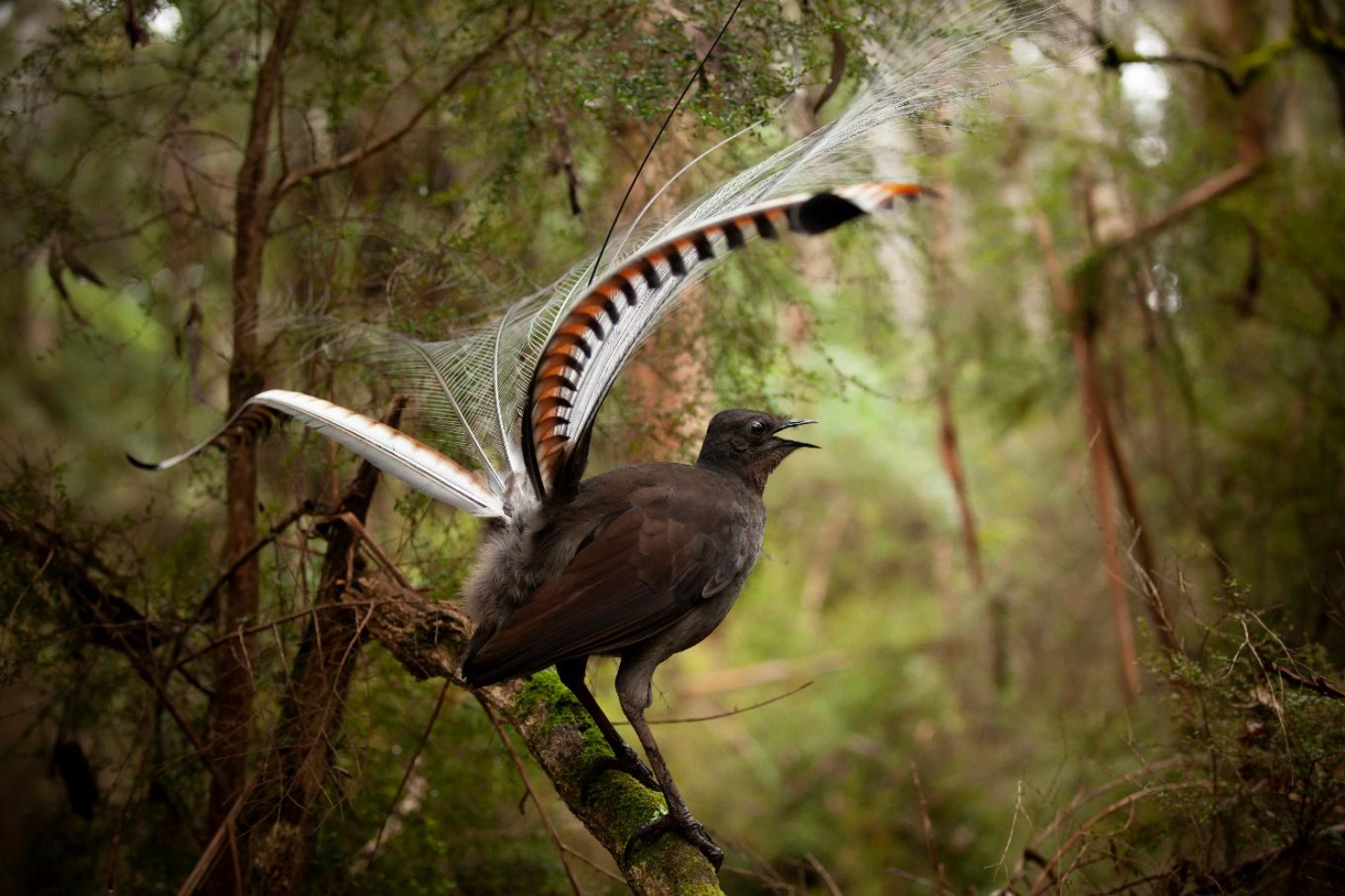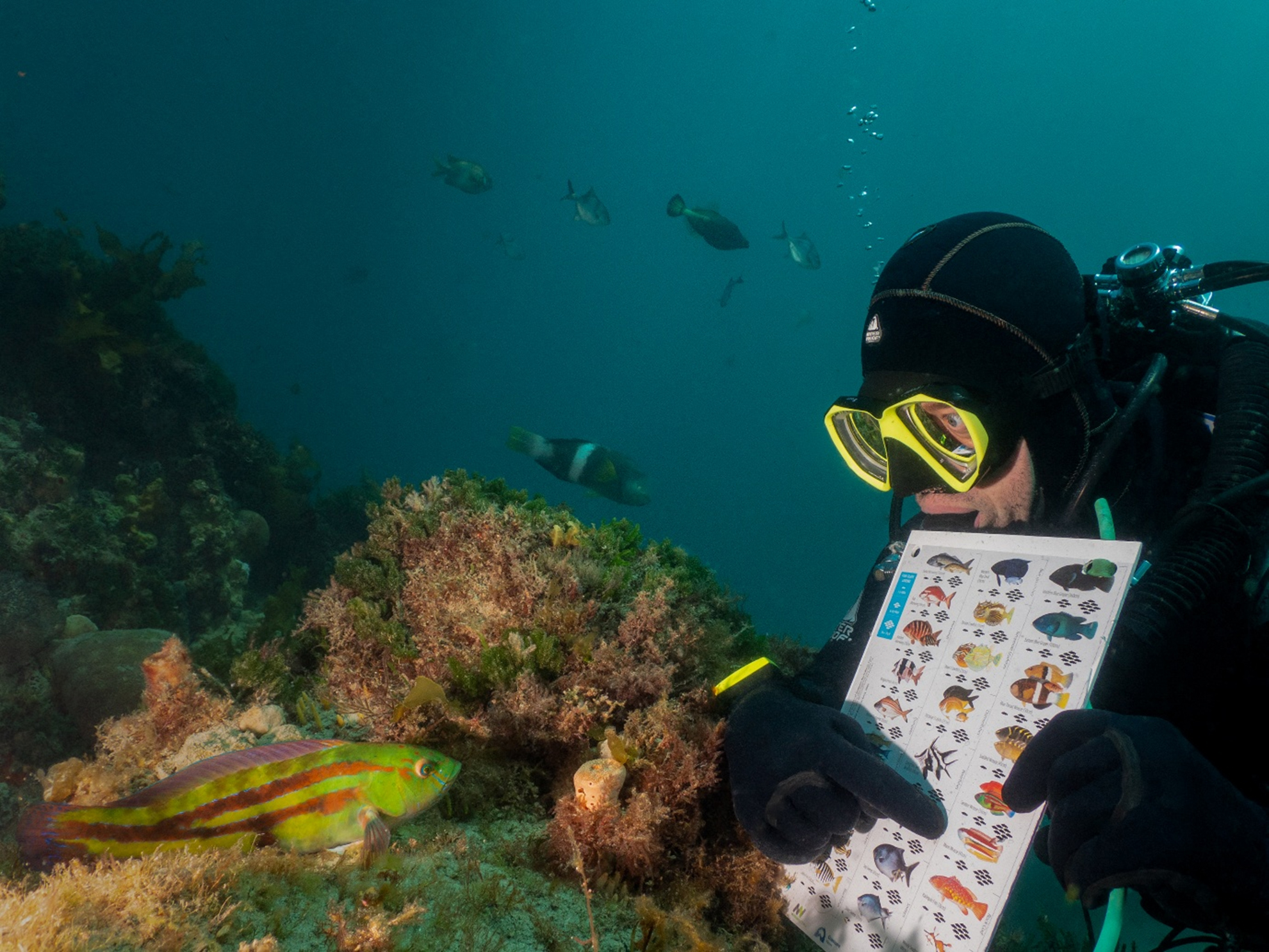by Scott Reddiex MRSV
As part of this year’s National Science Week, the Royal Society of Victoria partnered with the Victorian Parliamentarians for STEM to deliver the STEM and Society series of presentations. In the third of these presentations, Caring for the Rare, experts from Victorian institutions (Museums Victoria, Royal Botanic Gardens Victoria and Zoos Victoria) discussed our state’s threatened species, and the important work they are doing to keep these species from extinction.
[caption id="attachment_8739" align="alignright" width="300"]

The Helmeted Honeyeater, listed as critically endangered in Victoria.[/caption]You might be familiar with some of these threatened animals, like the Mountain Pygmy-possum, the Eastern Barred Bandicoot, the Baw Baw Frog, or the Helmeted Honeyeater. They are accompanied by threatened plant species like the Mountain Swainson-Pea, the Stony Bush-pea, or the plant that sounds like it needs its own superhero film: The Phantom Wattle.These are just a handful of the hundreds of species unique to this continent that are currently fighting for their survival, and urgent action is needed to ensure that they continue to contribute to Australia’s biodiversity.
Confined to History
However, for too many Australian native species, it is already too late. Since the arrival of Europeans in 1788, more than 100 species endemic to Australia have been documented as becoming extinct. Plants, fish, frogs, reptiles, birds, mammals, invertebrates, and even protists have all been eradicated from existence in the last 234 years[1]. It is almost impossible to determine the real/total number of species driven to extinction: without recorded observations, we cannot determine what existed.
The Importance of Remembrance
While the poster child for extinct Australian species is the Tasmanian tiger, there are many others you might be less familiar with. The value of learning about these species is understanding that the fate of the thylacine was not an isolated incident in Australia’s recent history – rather, it represents a story repeated so often that it lacks the shocking impact it should have. To compare with a different story that regularly draws greater national focus: every 4 years Australia has sent athletes to compete at the Olympic Games, while every 2.34 years Australia has completely removed another species from existence.
Toolache Wallaby (Notamacropus greyi)
[caption id="attachment_8740" align="alignright" width="300"]

A female Toolache Wallaby (N. greyi) featured in Transactions and Proceedings of the Royal Society of South Australia, Vol. LI. (1927)[/caption]The Toolache Wallaby (also referred to as Grey’s Wallaby) was described by the naturalist George Robert Waterhouse in his 1846 book A Natural History of the Mammalia. It was a reportedly elegant animal, which pre-disposed it to being hunted by Europeans for its pelt, and measured around 1.5m from nose to tail. Dr Hedley H. Finlayson of the South Australian Museum wrote of its appearance in 1927, “The early settlers were ill-disposed to see beauty many of the native animals, but a partial exception was made of the Toolach, which is very generally spoken of with some approach to admiration, even by those who have played a leading part in its destruction.”[2]Originally inhabiting swampy grassland of south-eastern South Australia, its numbers dwindled following the arrival of Europeans, who hunted the Toolache Wallaby for its pelt, destroyed its habitat, and brought the invasive European fox (Vulpes vulpes) to the continent.A last-minute attempt to save the species is documented in the Transactions and Proceedings of the Royal Society of South Australia. Zoologist Hedley H. Finlayson wrote that, by 1923, the only surviving population “was a small band of perhaps fourteen individuals, located on the south end of Konetta sheep run, some twenty-six miles south-east of Robe.”The conservation effort, led by Professor Frederic Wood Jones, had aimed to capture and relocate the animals to a sanctuary on Kangaroo Island. Unfortunately, this haphazard attempt instead resulted in the deaths of most of the wallabies they were trying to save. The last known Toolache Wallaby died in captivity in 1939.[3],[4]
Paradise Parrot (Psephotellus pulcherrimus)
[caption id="attachment_8741" align="alignleft" width="400"]

The Paradise Parrot, illustrated by H.C. Richter in The Birds of Australia, Vol. V by John Gould[/caption]Described by ornithologist John Gould in the fifth volume of The Birds of Australia 1848, the Paradise Parrot (also known as the ‘Beautiful Parakeet’) was originally found in the grassy woodlands along the NSW-Queensland border. As with all of Gould’s ornithological descriptions, its likeness was immortalised through illustration by Henry C. Richter.[5]Gould noted that the birds mostly ate seeds ‘from the grasses and other plants growing on the plains’ – which he of course confirmed by killing them and cutting open their stomachs.Between 1890 and 1900, the Paradise Parrot population declined significantly, thought to be the result of a number of factors: death of birds due to hunting/trapping (for aviaries, or to taxidermy and display) or predation by feral cats, and the destruction of habitat, through clearing of native grasses, overgrazing, and introduction of invasive species (such as the Prickly Pear Opuntia).[6]On the brink of extinction, in the 1920s it was determined that the birds survived as a small population near the town of Gayndah, Queensland. A conservation effort was launched by amateur ornithologist Alec H. Chisholm, however it proved too late, with the last confirmed sightings of the Paradise Parrot made in 1927.[7]The story of the Paradise Parrot is captured in Penny Olson’s book Glimpses of Paradise: The Quest for the Beautiful Parakeet (Publisher: National Library of Australia, ISBN: 9780642276520).In addition to the Paradise Parrot, John Gould documented more than 32 native Australian bird species. In her 2012 book, John Gould's Extinct and Endangered Birds (Publisher: National Library of Australia, ISBN: 9780642277657), Sue Taylor details those described by Gould that have since become endangered or extinct.
Victorian Grassland Earless Dragon (Tympanocryptis pinguicolla)
[caption id="attachment_8742" align="alignright" width="300"]

Illustration of the Victorian Grassland Earless Dragon (Tympanocryptis pinguicolla) by John James Wild. Published in The Prodromus of the Zoology of Victoria (1888) by former RSV President Frederick McCoy[/caption]The Victorian Grassland Earless Dragon is currently MIA, with the last confirmed sighting of the lizard made in 1969. With more than 50 years since it was last observed, it is likely extinct – however the hunt for any survivors is ongoing.[8]Its story highlights the difficulty in monitoring the status of a species. To paraphrase a famous thought experiment: if a lizard crawls through a forest floor, yet no-one is around to see it, how do we know it still exists?It also demonstrates the significance of taxonomy in determining extinction: it was thought that populations of T. pinguicolla persisted in other parts of the country, however all of these have subsequently determined to be distinct species.[9]Nevertheless, the quest to find the dragon continues. Zoos Victoria have been hunting for any signs of the lizard since 2017, as part of their Fighting Extinction program. Details of the hunt can be found at zoo.org.au/fighting-extinction/local-threatened-species/grassland-earless-dragon-victorian-species, and any potential dragon sightings can be reported at zoo.org.au/dragonsearch.
Yallara/Lesser Bilby (Macrotis leucura)
[caption id="attachment_8743" align="alignleft" width="300"]

The Yallara, or Lesser Bilby, in Thomas, O. (1888). Catalogue of the Marsupialia and Monotremata in the Collection of the British Museum (Natural History).[/caption]The Yallara (also known by the unfortunately prophetic name of ‘Lesser Bilby’) was one of only two species of bilby, with the other being the Greater Bilby (Macrotis lagotis) – which is itself currently facing extinction.Known by the Wangkangurru people as “Yallara”, it was smaller than its larger relative, and surprisingly aggressive. It inhabited the Great Sandy and Gibson deserts of Central Australia, with zoologist Hedley H. Finlayson noting in 1935 that the population was ‘plentiful’ near Cooncherie (north-eastern South Australia).[10]Given its relatively isolated habitat and nocturnal nature, its decline is attributed to the impact of introduced feral cats, foxes, and rabbits. The most recent physical evidence of the species is a skull found in the Simpson Desert in 1967, however it was determined that the animal had died ~15 years prior. Oral history of local indigenous communities places the last known sighting in the 1950s-1960s.[11]-----------Is there a particular extinct species of plant, fungus, fish, frog, reptile, bird, mammal, invertebrate, or protist whose story should be told? Are you involved in a citizen science project to conserve Australia’s unique biodiversity? Have you heard about the work to ‘de-extinct’ the thylacine? We’d love to hear your thoughts! Send us a letter at editor@sciencevictoria.org.au.
References
[1] Woinarski, J. C. Z., et al (2019). Reading the black book: The number, timing, distribution and causes of listed extinctions in Australia. Biological Conservation239, 108261[2]Transactions and Proceedings of the Royal Society of South Australia (Vol. LI, 1927), p363-377[3] Robinson, A.C. & M.C. Young (1983). The Toolache wallaby (Macropus greyi waterhouse). No. 54. Department of Environment and Planning, South Australian National Parks and Wildlife Service.[4] Smith, M.J. & A.C. Robinson (2008). Toolache Wallaby. In: Van Dyck, S. & R. Strahan, eds. Mammals of Australia, Third Edition. Sydney: Reed New Holland.[5] Gould, J. (1848). The Birds of Australia, Vol V. Published by the author, London.[6] Blakers, M. & Reilly, Pauline. & Davies, S. J. J. F. & Royal Australasian Ornithologists' Union. (1984). The Atlas of Australian birds. Melbourne University Press, Carlton.[7] Chisholm, A.H. (1945). Birds of the Gilbert diary. Part 2. Emu. 44:183-200.[8] Banks, C. B., Robertson, P., Magrath, M. J., & Harley, D. (2017). Searching for the Grassland Earless Dragon “Tympanocryptis pinguicolla” in Western Victoria. The Victorian Naturalist, 134(6), 187–198.[9] Melville, J., Chaplin, K., Hutchinson, M., Sumner, J., Gruber, B., MacDonald, A. J., & Sarre, S. D. (2019). Taxonomy and conservation of grassland earless dragons: new species and an assessment of the first possible extinction of a reptile on mainland Australia. Royal Society Open Science, 6(5), 190233[10] Finlayson, H. H. (1935). On mammals from the Lake Eyre Basin. Part II – The Peramelidae. Transactions and Proceedings of the Royal Society of South Australia 59, 227–236.[11] Burbidge A. A., Johnson K. A., Fuller P. J. Southgate R. I. (1988) Aboriginal knowledge of the mammals of the central deserts of Australia. Wildlife Research15, 9-39.
Discover how you can join the society
Join The Royal Society of Victoria. From expert panels to unique events, we're your go-to for scientific engagement. Let's create something amazing.












